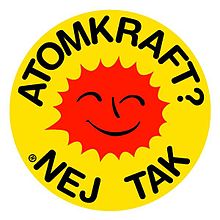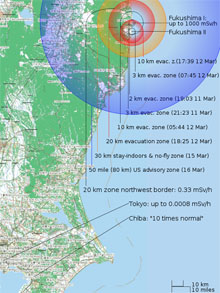« Prev Next »
 Sixteen days ago, a megathrust earthquake ocurred approximately 81 miles (130 kilometers) east of the Tōhoku region of Honshū, Japan, when the Pacific tectonic plate was subducted, or was forcibly overtaken, by the Okhotsk tectonic plate. With a Richter magnitude of 9.0, the quake was the fifth-largest since 1900, moving terrain near the epicenter roughly 13 feet (4 meters), shifting our planet's axis an estimated 6.5 inches (17 centimeters), and shortening the day's time by 1.8 microseconds.1 The seismic activity also prompted a tsunami that struck Japan minutes after the quake with waves of up to 77 feet (23.6 meters), reaching inland distances of around 6 miles (10 kilometers).
Sixteen days ago, a megathrust earthquake ocurred approximately 81 miles (130 kilometers) east of the Tōhoku region of Honshū, Japan, when the Pacific tectonic plate was subducted, or was forcibly overtaken, by the Okhotsk tectonic plate. With a Richter magnitude of 9.0, the quake was the fifth-largest since 1900, moving terrain near the epicenter roughly 13 feet (4 meters), shifting our planet's axis an estimated 6.5 inches (17 centimeters), and shortening the day's time by 1.8 microseconds.1 The seismic activity also prompted a tsunami that struck Japan minutes after the quake with waves of up to 77 feet (23.6 meters), reaching inland distances of around 6 miles (10 kilometers).
Though these figures are startling, I feel they may fail to represent the sorrow that must be reverberating throughout Japan and the rest of the world, as more than 10,000 people have died from the disaster with an additional 17,000 still missing. And as if this humanitarian emergency weren't enough, the Japanese are now having to contend with an aftershock of a completely different order: the threat of nuclear radiation.
This danger derives from the Fukushima Daiichi Nuclear Power Station, an energy plant 170 miles (273.6 kilometers) north of Tokyo. After tremors knocked out the station's electricity, tsunami water disabled the diesel back-up generators meant to keep the site's six nuclear reactors cool. Although only three reactors were in operation and all activity has been halted, its fuel rods of enriched uranium continue to be a problem because they still are decaying and emitting massive heat and radiation. These rods are held in containment vessels filled with water, but liquid in at least one reactor has reached the boiling point, causing explosions and releasing radioactive steam from subsequent fissures in the vessel walls. At the most critical location, Reactor 3, heat has totally evaporated the water, causing the exposed rods to burn out and expel black radioactive smoke. Because of this, the risk of radiation exposure remains serious and two recovery workers have already suffered injuries, leading to accusations of company mismanagement.2
 Before the disaster, nuclear power had met 30% of Japan's energy needs, but the programs at Fukushima Daiichi and Japan's fifteen other nuclear power plants have understandably now fallen under review. Regarding the endangerment of people living around the plant, radiation-contaminated foodstuffs such as milk and spinach have been reported up to 90 miles away from the site,3 while conflicting updates about radioactive water have complicated the response message.4 In reaction, nations have felt urged to review their nuclear policies, including China, Germany, Finland and South Africa, but public opinion ranges widely: while environmental groups protest the building of a power plant in Ontario, Canada, recent polls show that residents of one of the largest consumers of nuclear energy, France, still support it.
Before the disaster, nuclear power had met 30% of Japan's energy needs, but the programs at Fukushima Daiichi and Japan's fifteen other nuclear power plants have understandably now fallen under review. Regarding the endangerment of people living around the plant, radiation-contaminated foodstuffs such as milk and spinach have been reported up to 90 miles away from the site,3 while conflicting updates about radioactive water have complicated the response message.4 In reaction, nations have felt urged to review their nuclear policies, including China, Germany, Finland and South Africa, but public opinion ranges widely: while environmental groups protest the building of a power plant in Ontario, Canada, recent polls show that residents of one of the largest consumers of nuclear energy, France, still support it.
Notwithstanding these advocates, a renewed criticism of nuclear energy seems inevitable in the aftermath of the Japanese earthquake and tsunami. It's been twenty-five years since the last major nuclear disaster, at the Chernobyl plant in Ukraine, and we seem to be again at a time when nuclear energy is under serious reconsideration. In this setting, natural gas has emerged as an alternative resource and although imperfect, it does seem to be greener than coal and safer than nuclear power. While some nuclear proponents hope that new technologies will improve its safety, such as a group of Chinese researchers who invented uranium "pebbles" that allow for a more gradual nuclear reaction,5 in light of this ongoing crisis, I can't help but sympathize with the opposing position. In the words of one group of market researchers, "It could be that the Honshū earthquake is the catalyst which fundamentally reshapes our approach to global energy."6
Image Credits: Wikimedia
The first image shows one of many buttons produced after the 1986 Chernobyl disaster. "Atomkraft? Nej Tak" means "Nuclear Power? No Thanks" in Danish. The second is a map of progressing evacuation zones in relation to distance from the Fukushima Daiichi Nuclear Power Station.
1. Buis, A. "Japan Quake May Have Shortened Earth Days, Moved Axis." NASA. March 14, 2011.
2. Hamilton, J. and Xaykaothao, D. "Japan Government Criticizes Nuclear Plant Operator." US National Public Radio. March 26, 2011.
3. Belson, K. and Tabuchi, H. "Japan Finds Tainted Food Up to 90 Miles From Nuclear Sites." The New York Times. March 19, 2011.
4. Mandel, J. "Devil's in the Details for Drinking Water in Nuclear Accident Scenarios." Greenwire. March 25, 2011.
5. Bradsher, K. "A Radical Kind of Reactor." The New York Times. March 24, 2011.
6. Mouawad, J. "Natural Gas Now Viewed as Safer Bet." The New York Times. March 21, 2011.























In this way, the Fukushima disaster reminds me of the BP spill, in that the crisis was prolonged by mangagement lacking a Plan C after normal operations and Plan B failed. I also hope, though, that a safe and truly green energy becomes available soon, or even that we could innovate technologies that use less energy.
So, unless someone comes up with a new source of energy (which I really think we happen soon and revolutionize everything), nuclear is currently the way--tsunami or not, I'm afraid.